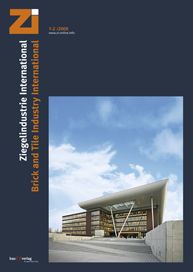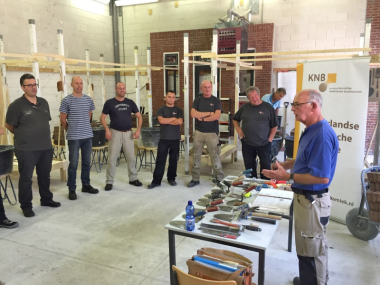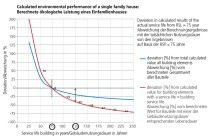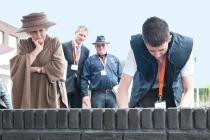Sustainability and the British brick industry
During the 1990s it was clear that sustainability would become an important issue for the brick industry. The case study will show how the industry faced the challenge of proving its sustainability credentials and will look at the threats and opportunities that the current situation poses in the United Kingdom. The study will discuss how the current regulatory regime in the UK has developed, investigating the inter-relationship of Government aspirations, research results, and manufacturing reality. It will report on how sustainability is being reduced to considerations of environmental assessment in the Code for Sustainable Homes published by the UK Government in 2007. The study will conclude with an indication of the likely impact of the Code for Sustainable Homes on the design of dwellings and the knock-on effect on the construction products industry in general and the brick industry in particular.
1 The UK brick industry
The United Kingdom brick industry produces 2.5 billion bricks per year from nearly 90 plants. It employs around 4 500 people and has a turnover approaching 550 million GBP. It is a well-established industry with many of the plants in rural locations where they are often the major employer in the area. Brick is a popular material, well liked by the public and appreciated by designers. 60% of the output is used in housing, 25% in repair and maintenance and the remainder in public projects, education, health and commerce.
Ten years ago “sustainability” was a word that was hardly part of the brick-maker’s vocabulary but the growing awareness of sustainability in the industry and the impact that the introduction of sustainability assessment methods has had on the industry makes an interesting case study.
2 Sustainable construction
The Building Research Establishment (BRE) at Watford made one of the earliest moves towards sustainable construction in the UK in the 1990s. The BRE assembled a set of elemental specifications for walls, roofs, floors and building components and then provided the relative environmental impacts of each one. In order to make the environmental assessment, BRE created a database of the environmental profiles of the materials involved, measuring each one against a range of impacts such as climate change, toxicity, fossil fuel and ozone depletion, levels of emission of pollutants and material for water extraction.
The brick industry was party to this operation and cooperated with the BRE in the production of a generic environmental profile for brick. The results of the study were published in the Green Guide and they became fundamental to the schemes for the environmental assessment of buildings produced by BRE.
3 The brick industry’s early involvement with sustainability
There is no doubt that this involvement with the BRE prompted the brick industry to take an interest in sustainability and in 2000 a Sustainability Working Group was set up. The Group was tasked with investigating ways that the industry could respond to the challenge of proving sustainability for the product to ensure that it did not suffer unduly in the market place. It was also to consider how the industry should respond to the challenge issued by the Government in its Sustainable Development Strategy of 1999 in which Trade Associations were invited to develop sector sustainability strategies that would provide a framework for sectors for the following aspects:
› to assess their economic, environmental and social performance
› identify areas for improvement in the light of future opportunities and threats
› set targets and implement action plans to bring about their improvement and then
› to report back on the process to stakeholders
In order to progress this, the Government set up a Pioneers Group in which a number of Trade Associations were given the opportunity to develop a sustainability strategy for their own sector in conjunction with other associations. The brick industry accepted the offer and embarked on the Sustainability Trail – a journey that has already had twists and turns and certainly shows no sign of finishing.
The Government was clear that sustainable development was about delivering a better quality of life for everyone now, and for generations to come. The four key objectives were seen as central to the enterprise:
› social progress
› protection of the environment
› prudent use of natural resources and
› maintenance of high and stable levels of economic growth and employment
The brick industry refined the definition of sustainability into “the responsible use of resources, be they human, physical, or financial”. A number of measurable objectives were to be declared and responsibility shown by the willingness to report annually on progress towards the objective. These key performance indicators were also to be reviewed annually so the activity of the industry was kept under scrutiny.
The industry declared 17 objectives: four under social progress, four under effective protection of the environment, five under the prudent use of natural resources, and three under the maintenance of high and stable levels of economic growth and employment. The spread across the four fields is important as it demonstrates that all aspects of sustainability are measured. As the story develops this broad spread is gradually focused into a narrow band that is concerned primarily with environmental aspects. One reason for this must be that this is where BRE started. Once you have developed a technique for producing an environmental profile and are using it as part of an assessment process then there is a temptation to continue working in that way. Another reason is that the UK Government has made commitments to reduce carbon emissions and inevitably efforts are intensified to achieve those targets. If they can be under the heading of “Sustainability” so much the better, even if it is in a restricted area of the concept.
However, the brick industry made its case across all aspects of sustainability. Probably the strongest point is that manufacturing is dispersed around the UK in factories located near the clay deposits. Hence it is possible to specify a material that is made locally, reinforcing the aesthetic impact of buildings by using local materials and reducing delivery costs. The manufacturing process has received massive investment since 1990. The industry was well aware of the need to reduce energy costs long before sustainability became fashionable. Alternative sources of energy have been investigated and there are now factories fuelled by the methane gas taken off the land-fill that has been encased in exhausted clay pits. Although the industry is cited as an “intensive energy user”, the reality is that the industry only consumes 1.5% of the total energy consumed by the UK manufacturing industry. The UK Government, working with the EU, now issues increasingly stringent targets for the reduction of energy use for individual industries. The brick industry has always met the targets imposed.
Beyond the factory gate brick contributes to the sustainability of the structure of which it is a part. It is extremely durable with little maintenance and will provide an attractive façade to a building almost indefinitely. It fulfils a variety of roles in building technology in providing physical support, security, protection from sound and fire, weather resistance and an appearance that is enhanced by age. Buildings built in masonry are easy to alter and adapt. We have examples of brick buildings entering a third or fourth life because they have been altered to accommodate new functions; the ability to change means that the initial investment is enhanced many times over.
Looking ahead, and considering the threat of global warming, it has been shown that as temperatures rise the heavy masonry structure with its high thermal mass will be able to moderate the effects of high temperature without recourse to air-conditioning. This is likely to be an important asset when the “future-proofing” of buildings is considered.
The Sustainability Strategy produced by the brick industry rehearsed the arguments outlined above. It was one of the first strategies to be produced by a sector working with the Pioneers Group but the context in which it had been produced was changing – something those of us concerned with sustainability are learning to get used to.
4 UK building regulations
Building regulations in the United Kingdom have a long history that can be traced back to 1666 and the aftermath of the Great Fire of London. More recently the Government has used the Regulations to control all aspects of building, and especially the insulation of buildings through “Part L” of the Regulations. The idea being that if you increase the insulation in a building you reduce the amount of energy required to heat it. This simple idea had been refined by the introduction of SAP or Standard Assessment Procedure. This is a method of analysis that looks at not only the insulation of a building but also at solar gain, heat production, siting and orientation to achieve a better understanding of how each aspect contributed to the thermal efficiency of the building. It was a cumbersome tool but it was significant because it was the first time that the Regulations had acknowledged that there are many inter-dependent factors that contribute to the performance of the building. Basic insulation standards under “Part L” were also raised but as far as brick was concerned the insulation material could still be accommodated in the 75–100 mm cavity brick/cavity block wall or within the framing of a lightweight frame with brick as an external skin.
However, when “Part L” values were reviewed in 2001 it was made clear by the construction industry that the regular increase in performance standards was difficult to handle. What was required was a longer-term prediction of how values might move with a number of milestones along the way that gave a programme for implementation. This suggestion was to become part of the strategy behind the Code for Sustainable Homes.
5 The building industry and the drive for improved efficiency
The efficiency of the building industry had been addressed in a number of reports that had been compiled in the 1990s. The Latham Report 1994 and the Egan Report 1998 proposed a number of measures to improve the situation but a common theme was that by removing construction from the site into the factory there would be worthwhile benefits. It was claimed that factory production would give greater accuracy, guarantee performance standards, and reduce construction waste. Site assembly rather than site production would give faster build times with predictable performance and fewer defects. This halcyon vision had been a reality in the 1960s when, in an effort to solve the housing crisis, the Government had backed the introduction of factory-produced site-assembled building systems. The point that we are still paying the price of this venture was ignored. There was faith that a more experienced industry would be able to make it work the second time around.
The prospect of “modern methods of construction” was seen as an opportunity not only to increase the number of dwellings built per year but also to ensure that they were technically superior to any mass housing produced previously. This was good news for the Government who were anxious to increase the rate of build from around 180 000 to 250 000 dwellings per year and also to ensure that these homes were technically sophisticated.
6 The Code for Sustainable Homes
The upshot of all this activity was the publication in December 2006 of the “Code for Sustainable Homes”. This document claimed to herald a step change in sustainable home-building practice. Based on the proposition that in 2004 more than a quarter of the UK’s carbon dioxide emissions came from the energy used to heat, light, and run our homes, it concluded that it is vital to ensure that homes are built in a way that reduces the use of energy and harmful emissions. In addition to the reduction of CO2 the Code also suggested standards for the use of water within the home and the collection of surface water, the promotion of health and well-being and the reduction of waste and pollution from materials as well as the sustainability of the materials themselves. Code compliance is voluntary but it is likely that assessment under the Code standards will be mandatory in the future. The key point is that the Code sets out six levels of performance so that industry is able to understand how the standards will change with time. These code levels each show an improvement in “carbon performance” when compared with the Target Emission Rate (TER) defined by the 2006 Building Regulations Standards:
› Level 1 shows a 10% improvement over 2006 TER
› Level 2 shows a 18% improvement over 2006 TER
› Level 3 shows a 25% improvement over 2006 TER
› Level 4 shows a 44% improvement over 2006 TER
› Level 5 shows a 100% improvement over 2006 TER
› Level 6 shows a “zero carbon” improvement over 2006 TER
When the “carbon performance” for a building is determined a number of credits are assigned to the building. Credits are also scored for:
› the environmental profile of materials used
› the predicted water consumption per person per day
› means of controlling surface water run-off
› facilities provided for minimizing waste during construction and recycling/composting waste during habitation
› the limitation of the global warming potential of insulants and emissions of nitrous oxide from space and water heating systems
› the standard of daylight and sound insulation
› the quality of a management system for the building itself and the ecology around it
Each of the headings has a number of sub-headings that are also potential credit earners. The credits are converted to points by a multiplier that is different for each category and the code level is determined by the number of points achieved.
This system has much to commend it:
› It provides industry with a clear development path
› It is flexible in that there is no one way of achieving a particular level
› It considers the whole house and the way in which it is used
› It is voluntary and therefore housing developers are able to gain market advantage by complying with higher code levels
The system has stimulated debate and activity in an industry that has realized there is no time to be lost if the Government is to stick to its intention of requiring all new private sector homes to be Code level 3 by 2010, Code level 4 by 2013, and Code level 6 – zero carbon by 2016.
Now that the dust has settled it has become clear that level 3 can be achieved by improving current standards;
level 4 will require some innovation, especially with regard to renewable energy; and level 5 and 6 require some major shifts in the way energy is supplied to, and used, in the house. It appears that once the fabric of the house is able to achieve level 4, the higher levels will be achieved through other means.
7 Implications of the Code
A number of “demonstration” homes have been constructed at the BRE’s Innovation Park. Initially it was considered that conventional brick and block construction would not be able to provide the air-tightness required by the higher levels of the Code. But this perception has proved false and it is the framed structures that are struggling to achieve the standards.
The debate about standards and methods of construction is vitally important to the masonry industry in general and the brick industry in particular. If there is wholehearted acceptance that the only way to solve the problems of constructing these homes is by lightweight frameworks manufactured off-site then it is likely the designer will use alternative material on the external face. There is a temptation to go down that road, especially as it seems to offer the easy “quick-fix” solution.
However, there are also strong arguments, not just for the use of a brick/block solution, but also for a serious research programme to investigate the development of what is called “traditional” construction.
There are 180 000 homes built each year in England, Wales and Northern Ireland. Of these some 15% are made from lightweight framing – so “traditional” construction is providing the bulk of homes. What is needed is a thorough examination of the “traditional package“. Greater efficiency could be achieved by rationalizing the dimensions of brickwork and components, investigating ways of incorporating standard units, such as pre-fabricated floors and service pods, the use of wiring looms and prefabricated plumbing. There is also room for the development of alternative methods of insulation. Currently the solution to increasing the “U“ value of a wall is seen as making it wider to allow more insulation to be inserted. There is potential in vacuum insulation panels that would satisfy the most stringent code level in a thickness of 30 mm. It would be a neat trick if the insulation became a positive element around which the building is built, rather than a void that is simply filled.
The assembly of brick and block will also need to be carefully considered. There are sufficient bricklayers to cope with the predicted increase in the provision of homes but the higher standards of air-tightness will demand that the work is carried out with greater care and attention to detail. There are also new techniques for providing brick/block walls. The “Hanson House” on the BRE Innovation Park has cavity walls assembled in a factory using glued mortar and delivered to site in large panels 2 400 x 5 000 mm – thus combining the timeless qualities of brick with off-site techniques.
When the brick industry produced the original Sustainability Strategy, no one imagined that within a few years we would be involved in a project like the Code for Sustainable Homes. The irony is that in the Code the only aspect of sustainability that is considered in the material section is that of “Environmental Sustainability”. However, lurking in the Code is the possibility of points for Responsible Sourcing of Materials. Current thinking between BRE and the Trade Associations is that this is an area where credit will be obtained for an all-round approach to sustainability. Once more we will have the opportunity to demonstrate that the brick industry promotes “the responsible use of resources, be they human, physical or financial”.






